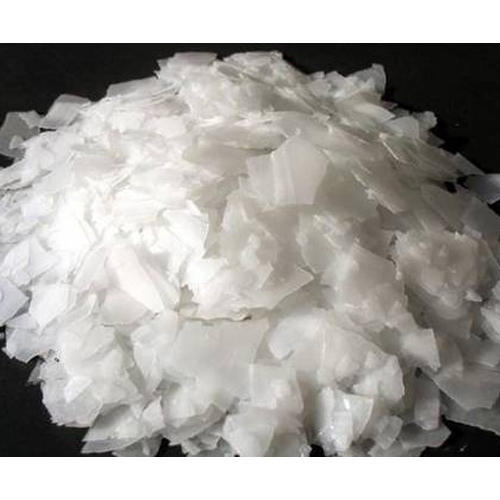
KOH (Potassium Hydroxide)
Potassium hydroxide is an important inorganic base, and is also called caustic potash or potash lye. KOH is a potent base that is marketed in several forms including pellets, flakes, and powders. It is used in various chemical, industrial and manufacturing applications.
The chemical formula of potassium hydroxide is KOH, and its molar mass is 56.11 g/mol. The structure of KOH consists of an ionic bond between the potassium metal cation and the hydroxyl anion, as shown below. Solid KOH is found in a rhombohedra crystalline structure, similar to that of sodium chloride.

The industrial preparation of KOH is similar to that of NaOH, by the chloralkali process. It is prepared by the electrolysis of potassium chloride solutions, along with chlorine gas as a by-product:
2KCl + 2 H2O → 2KOH + Cl2 + H2
Potassium hydroxide is a white solid with a density of 2.12 g/mL, a melting point of 360°C, and boiling point of 1,327°C. It is typically available as translucent pellets, or as aqueous solutions of different concentrations.
Estimated world-wide demand of potassium hydroxide was higher than 1 million tons expressed as KOH 100% in 1994. The global demand is expected to grow with 4.0% per year. KOH is a white and deliquescent solid with a low vapour pressure. It is a strong alkaline substance that dissociates completely in water to potassium and hydroxyl ions. Figure (1) shows world distribution demand for KOH.

Fig. (1): World distribution demand for KOH
Potassium hydroxide is used in many of the same applications as sodium hydroxide. In addition, aqueous KOH is used as the electrolyte in alkaline batteries. It is also used to manufacture soft soaps and liquid soaps by saponification. Many industrially useful potassium salts are prepared by reaction with KOH. Some of the other uses of KOH are in chemical manufacturing, fertilizer production, petroleum refining, and cleaning solutions.
Potassium hydroxide solid is used as an intermediate in a wide range of manufacturing processes, from the production of pharmaceuticals and fertilisers, to its use in petroleum refining. In addition, it is a precursor to other potassium compounds. KOH is a highly hygroscopic solid, meaning it attracts and holds water molecules from the surrounding environment, making it a useful laboratory desiccant (drying agent).
In addition to the above uses, potassium hydroxide is also used in making soap, as an electrolyte in alkaline batteries and in electroplating, lithography, and paint and varnish removers. Liquid drain cleaners contain 25 to 36% of potassium hydroxide. Medically, potassium hydroxide (KOH) is widely used in the wet mount preparation of various clinical specimens for microscopic visualization of fungi and fungal elements in skin, hair, nails, and even vaginal secretions. Recently, it has been studied for efficacy and tolerability in the treatment of warts. It was determined that topical KOH solution was found to be a safe and effective treatment of plane warts.
